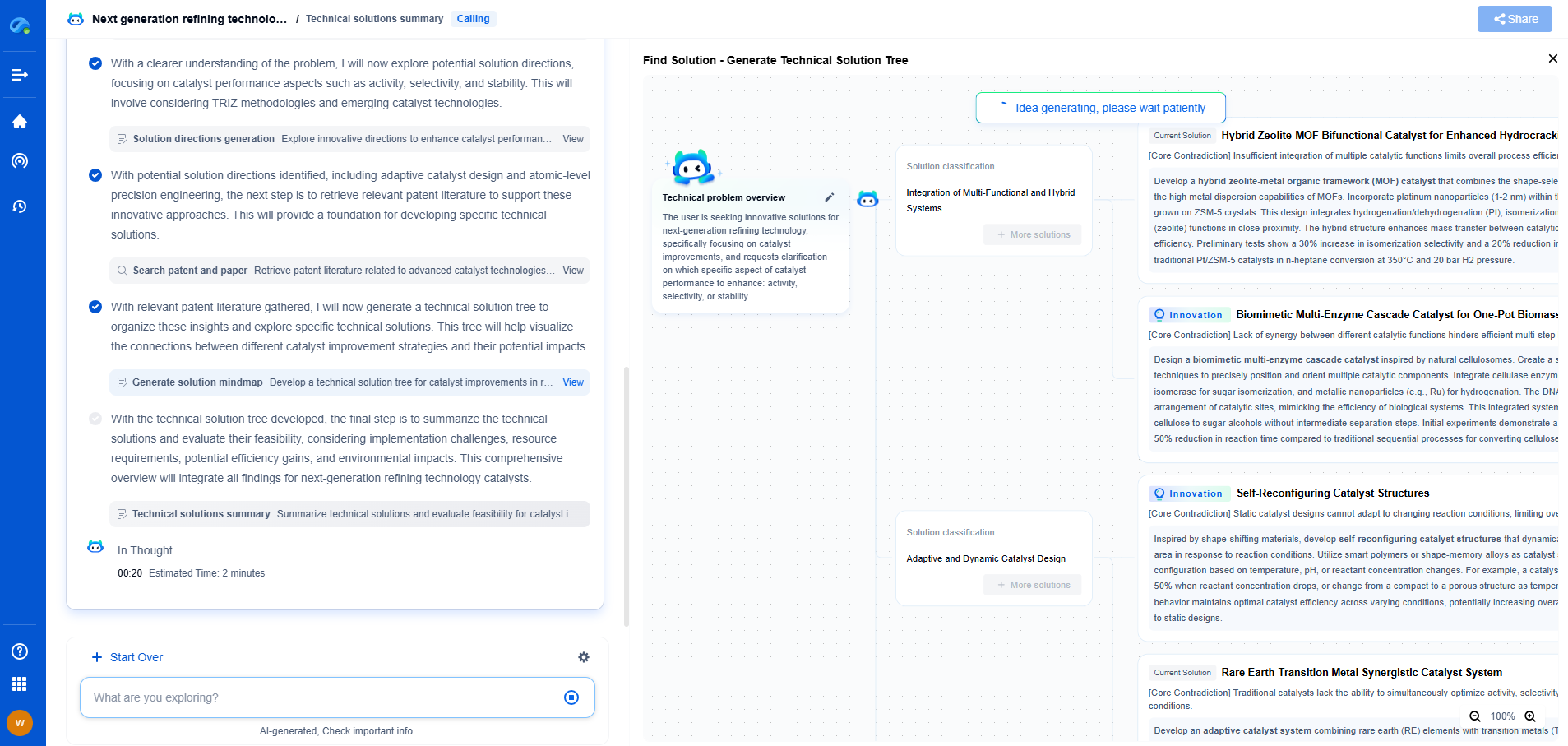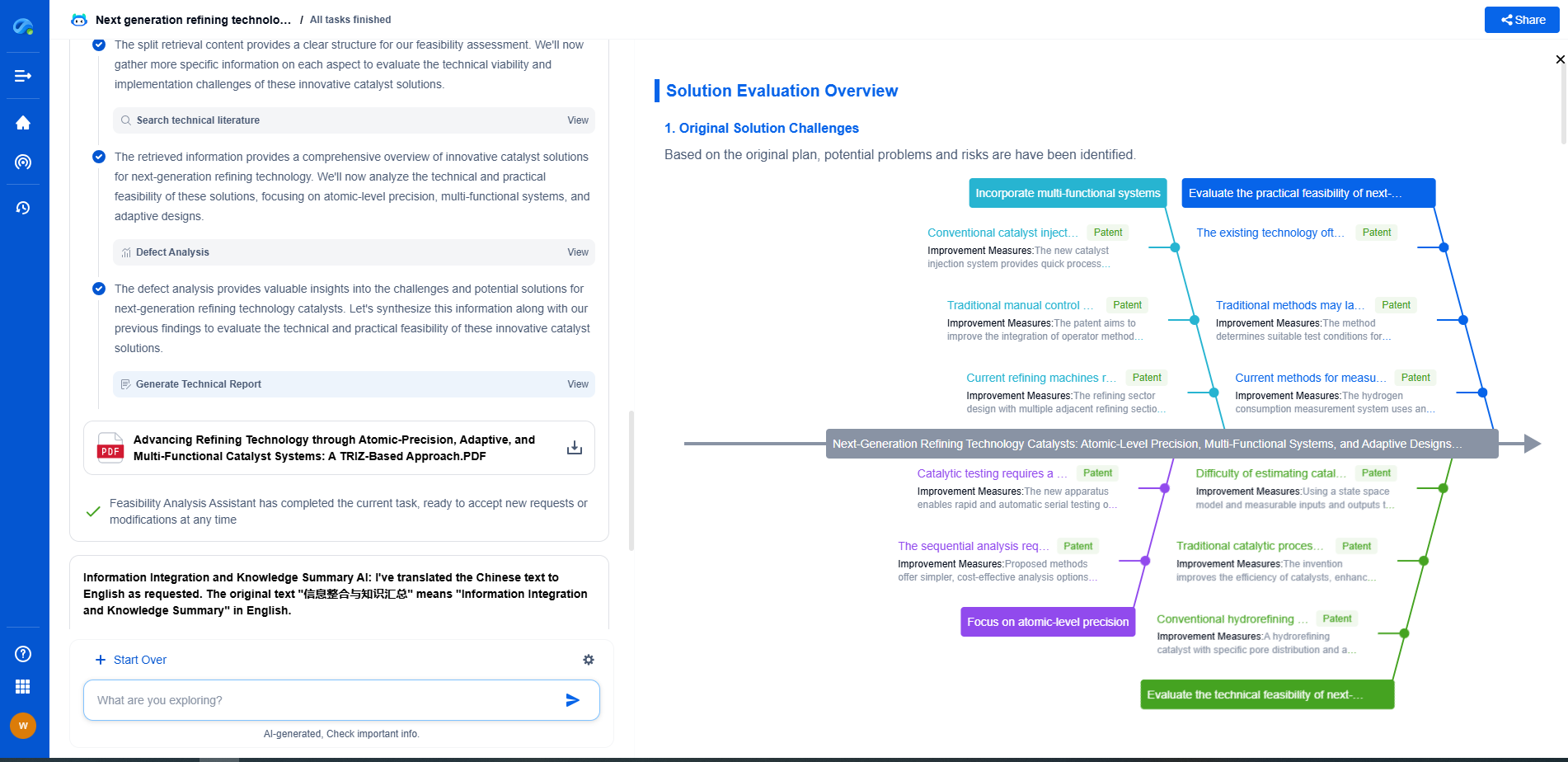AI-Based vs Manual Monitoring in Filtration Systems: Pros & Cons
JUL 25, 2025 |
In the world of industrial processes, effective filtration systems play a crucial role in ensuring the smooth operation and longevity of equipment. These systems, which are vital for removing contaminants from fluids, gases, or air, can be monitored using either AI-based technology or manual methods. Both approaches have their respective merits and demerits. This blog aims to delve into the advantages and disadvantages of AI-based versus manual monitoring in filtration systems, helping organizations make informed decisions on which method best suits their operational needs.
Understanding AI-Based Monitoring in Filtration Systems
AI-based monitoring utilizes advanced algorithms and machine learning techniques to oversee filtration processes. By analyzing data in real-time, AI systems can predict failures, optimize maintenance schedules, and improve efficiency. This technology is particularly beneficial in settings where the complexity of filtration systems makes manual monitoring impractical or inefficient.
Pros of AI-Based Monitoring
1. **Real-Time Data Analysis**: AI systems can process vast amounts of data quickly, providing real-time insights into the performance of filtration systems. This allows for immediate corrective actions, minimizing downtime and preventing potential failures.
2. **Predictive Maintenance**: By analyzing historical data and identifying patterns, AI can predict when a filtration system is likely to require maintenance. This proactive approach helps in scheduling maintenance at the most convenient times, reducing the risk of unexpected breakdowns.
3. **Increased Efficiency**: AI optimizes filtration processes by adjusting parameters in real-time to meet changing conditions. This results in improved efficiency and energy savings, ultimately lowering operational costs.
Cons of AI-Based Monitoring
1. **High Initial Costs**: Implementing AI-based monitoring systems requires significant investment in technology and infrastructure. For small to medium-sized companies, these costs might be prohibitive.
2. **Complexity and Dependence**: AI systems can be complex to install and configure, requiring specialized knowledge. Additionally, over-reliance on AI might lead to a lack of skilled human resources capable of manual monitoring if needed.
3. **Data Privacy Concerns**: The use of AI involves collecting and analyzing large amounts of data, which raises concerns about data security and privacy.
Exploring Manual Monitoring in Filtration Systems
Manual monitoring relies on human operators to oversee the functioning of filtration systems. This traditional approach involves regular inspections, data logging, and maintenance conducted by skilled technicians.
Pros of Manual Monitoring
1. **Human Intuition and Experience**: Skilled technicians can draw on years of experience, using intuition to detect issues that might not be apparent from data alone. This human touch can be invaluable in complex situations where nuanced judgment is required.
2. **Lower Initial Investment**: Manual monitoring does not require the extensive technological infrastructure that AI-based systems do, making it more accessible for businesses with limited budgets.
3. **Flexibility**: Human operators can adapt quickly to changes and unexpected situations, providing a level of flexibility that AI systems may lack.
Cons of Manual Monitoring
1. **Limited by Human Capacity**: Manual monitoring is constrained by the physical and cognitive limits of human operators. It is less efficient for processing large volumes of data and may not be as effective in identifying patterns as AI systems.
2. **Inconsistency and Human Error**: The quality of manual monitoring can vary significantly depending on the skill and attentiveness of the operators. Human error is an inevitable risk, potentially leading to missed issues or misinterpretations.
3. **Time-Consuming**: Regular manual inspections can be time-consuming and labor-intensive, diverting resources from other critical tasks.
Conclusion
The choice between AI-based and manual monitoring in filtration systems depends on various factors, including budget, operational complexity, and the specific needs of an organization. While AI offers real-time insights, predictive maintenance, and improved efficiency, it comes with high initial costs and complexity. On the other hand, manual monitoring provides the benefit of human intuition and lower initial investment but is limited by human capacity and is more prone to errors. Organizations must weigh these pros and cons carefully to select the most suitable monitoring approach for their filtration systems, ensuring optimal performance and longevity.
From next-generation membrane materials to high-efficiency separation processes for pharmaceuticals, water treatment, food processing, or energy systems, the filtration & separation industry is rapidly evolving with a surge in material innovation, microstructure design, and process optimization.
Patsnap Eureka, our intelligent AI assistant built for R&D professionals in high-tech sectors, empowers you with real-time expert-level analysis, technology roadmap exploration, and strategic mapping of core patents—all within a seamless, user-friendly interface.
Whether you're designing the next high-throughput filter, optimizing nanostructured surfaces, or exploring new separation media for emerging industries—Patsnap Eureka gives you AI-driven insights in seconds, helping you move from ideation to innovation with confidence.
🚀 Start your free trial today and experience how Eureka transforms filtration innovation—from reactive to predictive.
- R&D
- Intellectual Property
- Life Sciences
- Materials
- Tech Scout
- Unparalleled Data Quality
- Higher Quality Content
- 60% Fewer Hallucinations
Browse by: Latest US Patents, China's latest patents, Technical Efficacy Thesaurus, Application Domain, Technology Topic, Popular Technical Reports.
© 2025 PatSnap. All rights reserved.Legal|Privacy policy|Modern Slavery Act Transparency Statement|Sitemap|About US| Contact US: help@patsnap.com

